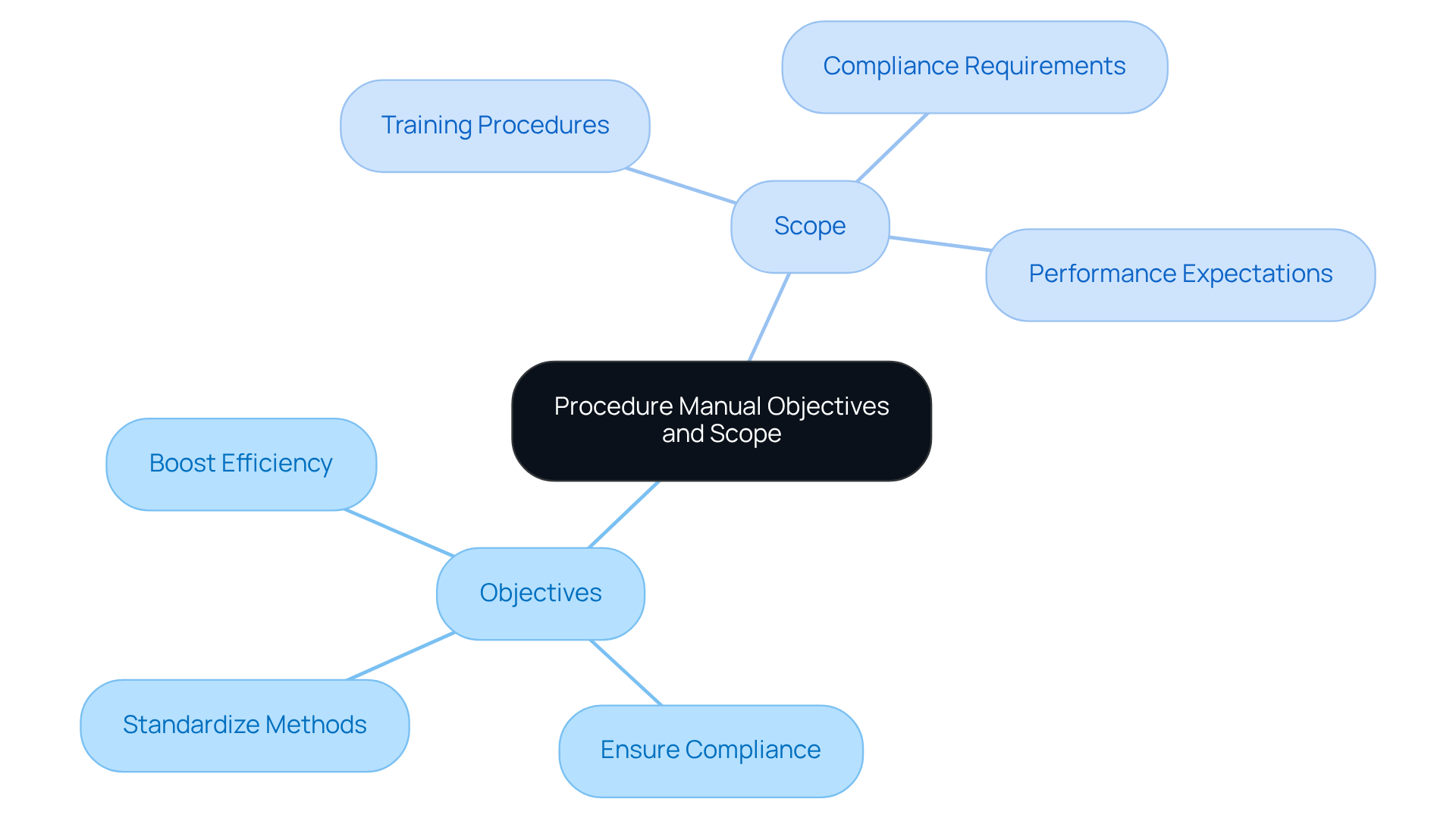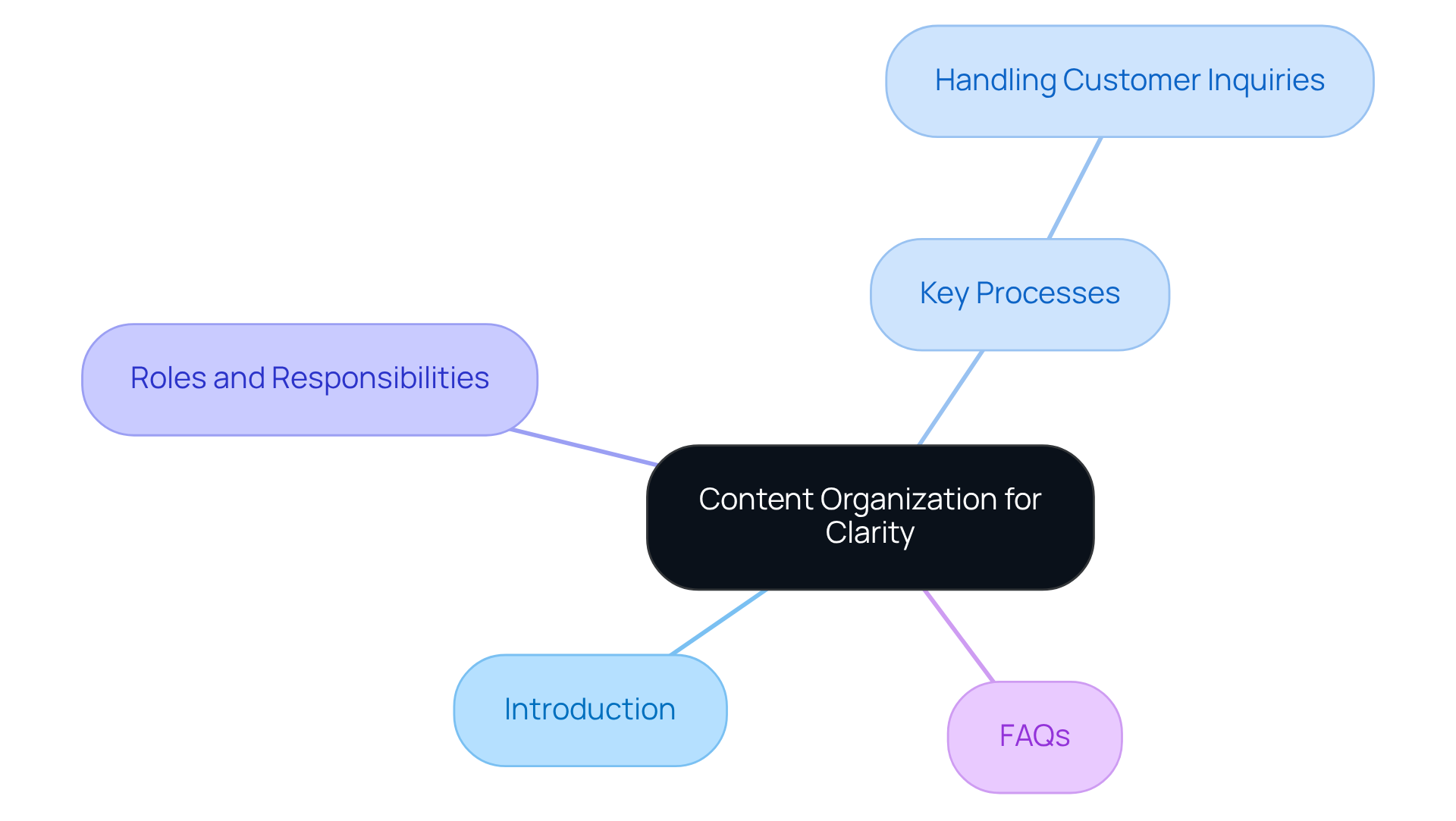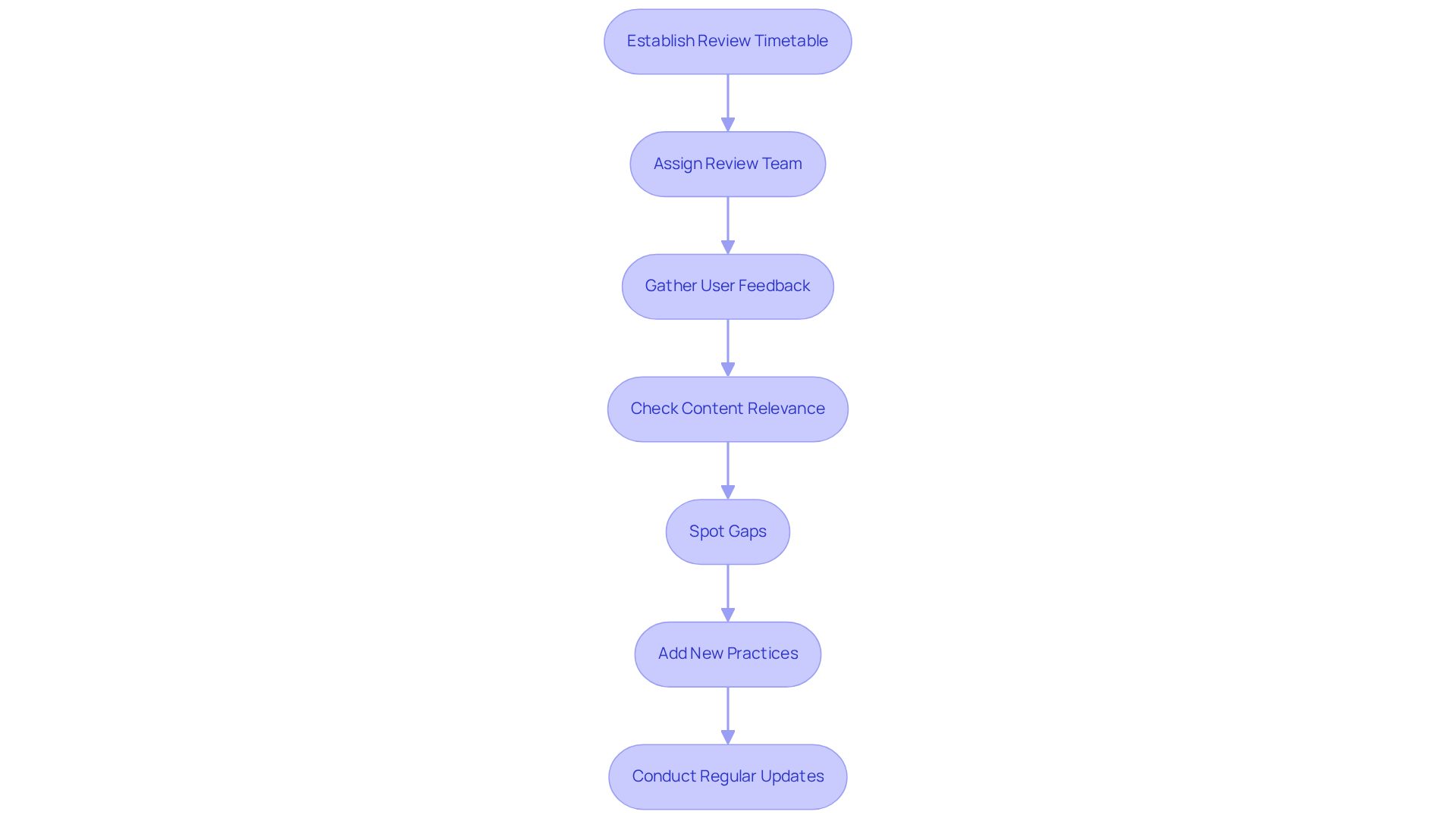
Overview
You might be wondering how to create an effective procedure manual. Well, there are four key steps to get you started!
- Define your objectives and scope.
- Identify the key processes and stakeholders involved.
- Organize your content for clarity.
- Establish a review and update process!
Now, let’s dive into why these steps matter. Each one enhances operational efficiency and compliance, making your manual not just a document, but a valuable resource. Plus, engaging your stakeholders and regularly reviewing your content helps keep everything relevant and effective. So, what do you think? Ready to tackle your documentation challenges together?
Key Highlights:
- Define objectives for a procedure manual to boost operational efficiency and ensure compliance.
- Clear scope definition helps avoid misunderstandings and specifies what the guide will cover.
- Involve stakeholders from various departments to gather insights on essential procedures.
- Engagement with stakeholders increases the likelihood of achieving organisational goals by 50%.
- Organise content into coherent sections and use visual aids to enhance understanding.
- Regular review and update processes are essential for keeping the manual relevant and effective.
- SowFlow simplifies documentation and helps maintain organised, up-to-date guidelines.
Introduction
Creating a procedure manual isn’t just another bureaucratic task; it’s actually the backbone of operational efficiency and compliance in any organization. You might be wondering how defining clear objectives and engaging the right stakeholders can really make a difference. Well, companies that do this can streamline their processes and boost productivity. But here’s the catch: keeping these manuals relevant and user-friendly in our fast-paced business world can be quite a challenge.
So, what are the key steps organizations need to take to craft a procedure manual that not only meets regulatory standards but also empowers employees to do their jobs effectively? Let’s dive into that!
Define Objectives and Scope of the Procedure Manual
When you're looking to develop a guidelines document, the first step is to pinpoint the main goals you want to achieve. You might be thinking, what exactly are these goals? Well, they could range from boosting efficiency in operations to ensuring compliance or standardizing methods. For instance, did you know that financial organizations that weave regulatory adherence into their operational systems end up spending 41% less on compliance efforts? Plus, they see 27% fewer regulatory findings! This really underscores how operational efficiency plays a vital role in procedural guidelines.
Now, let’s talk about defining the scope. It’s super important to outline what your guide will cover and what it won’t. If your guide is all about onboarding new employees, make sure to specify which departments and processes are included. This clarity helps avoid any misunderstandings and ensures that your guide does its job effectively.
For example, a company might set a clear objective for its guide as 'to provide a comprehensive overview for onboarding new hires in the sales department.' The scope could include:
While leaving out unrelated departments like IT or HR. As Winston Churchill once said, "Plans are of little importance, but planning is essential." This really highlights how crucial thorough planning is for achieving effective outcomes. By organizing your approach, you not only enhance the guide's effectiveness but also significantly boost efficiency, simplifying onboarding and cutting down on training time. So, are you ready to dive into creating your own guidelines?

Identify Key Processes and Stakeholders
Once you’ve defined your objectives and scope, what's next? It’s time to pinpoint the key activities that your manual will cover. Involving folks from different departments is super important for gathering insights on which procedures are essential for operational success. This could mean chatting with team leaders, sending out surveys, or even digging into existing documentation.
Now, here’s where SowFlow steps in and makes everything easier. It allows teams to whip up SOPs and training resources right in the browser, so you can say goodbye to the hassle of separate screenshots and complicated documentation tasks. As Anastasia Masadi, a Product Owner, puts it, "SowFlow has been a game changer in the way we document work and deliver to our clients. SowFlow gave me time from my life back."
You might be wondering what this looks like in practice. For a guide focused on customer service, you’d want to cover essential procedures like:
- Handling customer inquiries
- Processing returns
- Managing complaints
Think about who you’d want to involve—customer service reps, team leaders, and quality assurance folks can all share valuable insights on best practices and common challenges.
Did you know that companies that engage with stakeholders are 50% more likely to hit their big goals? That really highlights how crucial this engagement is! But, let’s not sugarcoat it—challenges like tokenistic involvement and power imbalances can get in the way of effective stakeholder engagement. So, clear communication about why you’re engaging is key. It helps everyone understand their role and influence in the process. Plus, incorporating feedback from stakeholders not only makes your document more relevant but also builds a sense of ownership among those involved. For example, the World Health Organization emphasizes that when you involve citizens in policy-making, it can lead to more effective and equitable outcomes. By addressing these challenges and ensuring meaningful involvement, organizations can create guidelines that truly reflect the needs and practices of their teams.

Organize Content for Clarity and Accessibility
To guarantee clarity and accessibility in a guide, you might be wondering how to best arrange the content. It’s vital to break it down into coherent sections and subsections. By using headings and subheadings effectively, you can transform complex information into manageable parts, making it easier for users to comprehend. And let’s not forget about visual aids! Incorporating flowcharts, diagrams, and checklists can significantly enhance understanding. Did you know that studies show 67% of individuals complete tasks more effectively with visual instructions rather than text alone?
Now, speaking of making things easier, [SowFlow's instant documentation solution](https://sowflow.io) is here to save the day! It allows you to create visual aids and organized layouts effortlessly, making updates and revisions a breeze. This ensures your guides remain relevant in our ever-evolving business world. Plus, creating a table of contents and an index helps users navigate quickly, allowing them to find what they need in no time. For instance, a well-organized guidelines document might include sections like:
- Introduction
- Key Processes
- Roles and Responsibilities
- FAQs
Each section can be further divided into subsections, like 'Handling Customer Inquiries' under 'Key Processes.' This structured approach not only boosts clarity but also empowers users to engage with the documentation more effectively.

Establish a Review and Update Process
To keep your operations manual fresh and relevant, you might be wondering how to develop a sample of procedure manual. Establishing a regular review timetable is essential, for instance, a sample of procedure manual that suggests yearly or semi-annual reviews. It’s a good idea to assign a dedicated team or individual to oversee these reviews, as described in the sample of procedure manual, gathering feedback from users to inform those all-important updates. This approach should include checking if the current content still makes sense, spotting any gaps, and adding new practices as they pop up, as outlined in a sample of procedure manual.
For instance, imagine a company that holds quarterly evaluation sessions where the customer service team gathers to chat about any changes in practices or policies. The insights from these meetings can be super helpful in updating the sample of procedure manual, ensuring that it reflects the latest practices and continues to function effectively.
But wait, there’s more! Regular updates aren’t just a nice-to-have; they’re essential for maintaining the sample of procedure manual, staying compliant with industry standards, and minimizing the risk of errors. As industry experts often say, 'A sample of procedure manual should be regularly reviewed and updated to ensure it remains relevant and effective.'
Now, let’s talk about how SowFlow can make this process a breeze. With SowFlow, you can whip up documentation easily and keep everything organized, ensuring updates are timely and thorough. Plus, you get unlimited access to all the software's features, expert help, and best practices for effective knowledge management. This commitment to continuous improvement not only fosters a culture of quality and consistency but also boosts operational efficiency. And hey, SowFlow even offers a free trial, so you can see these benefits for yourself!

Conclusion
Creating an effective procedure manual is essential for any organization looking to streamline operations and boost compliance. You might be wondering how to get started, right? By honing in on clear objectives and defining the manual's scope, you can lay the groundwork for a document that not only guides but also empowers your team. And let’s not forget the importance of involving key stakeholders throughout the process; their insights are invaluable in keeping the manual relevant and practical.
So, what are the key steps?
- Identifying essential processes
- Organizing content for clarity
- Setting up a solid review and update mechanism
Engaging with stakeholders and using tools like SowFlow can really lighten the load of documentation, making everything more efficient and user-friendly. Plus, regular reviews and updates are a must to adapt to changing practices and ensure compliance, so your manual continues to serve its purpose.
Ultimately, creating a procedure manual isn’t just about putting words on paper; it's about nurturing a culture of continuous improvement and operational excellence. Organizations should definitely prioritize these best practices when developing their procedure manuals. Trust me, doing so will lead to enhanced efficiency, lower compliance costs, and a more engaged workforce. Taking that first step towards crafting a comprehensive and accessible procedure manual can unlock significant long-term benefits for your organization!
Frequently Asked Questions
What is the first step in developing a guidelines document?
The first step is to define the main objectives you want to achieve, such as boosting efficiency, ensuring compliance, or standardizing methods.
Why is it important to define the objectives of a procedure manual?
Defining objectives is crucial because it helps focus the manual on specific goals, such as improving operational efficiency and reducing compliance costs.
What are some examples of objectives for a guidelines document?
Examples of objectives include enhancing operational efficiency, ensuring regulatory compliance, and standardizing methods across processes.
How does defining the scope of a guidelines document help?
Defining the scope clarifies what the guide will cover and what it won’t, helping to avoid misunderstandings and ensuring the guide is effective.
Can you provide an example of a clear objective and scope for a guidelines document?
An example objective could be 'to provide a comprehensive overview for onboarding new hires in the sales department,' with the scope including training procedures, compliance requirements, and performance expectations, while excluding unrelated departments like IT or HR.
What is the significance of planning in creating a guidelines document?
Planning is essential as it enhances the effectiveness of the guide, boosts efficiency, simplifies onboarding, and reduces training time.
👍
What others are liking
5 Steps to outline your ideal documentation structure
5 MINS READ
Where to start the your journey of mapping out your ideal documentation structure, aligning it with the very heartbeat of your organization?
Defining a winning level of detail in your process
3 MINS READ
What is too much detail, and what is too little? This article described in that winning level detail about what detail is enough.





